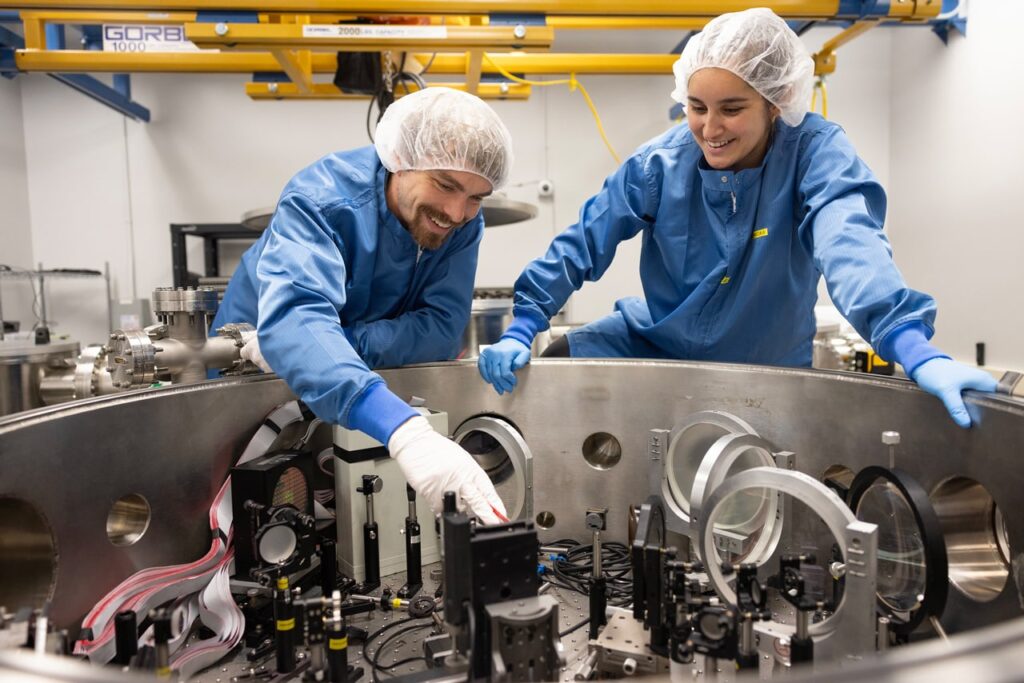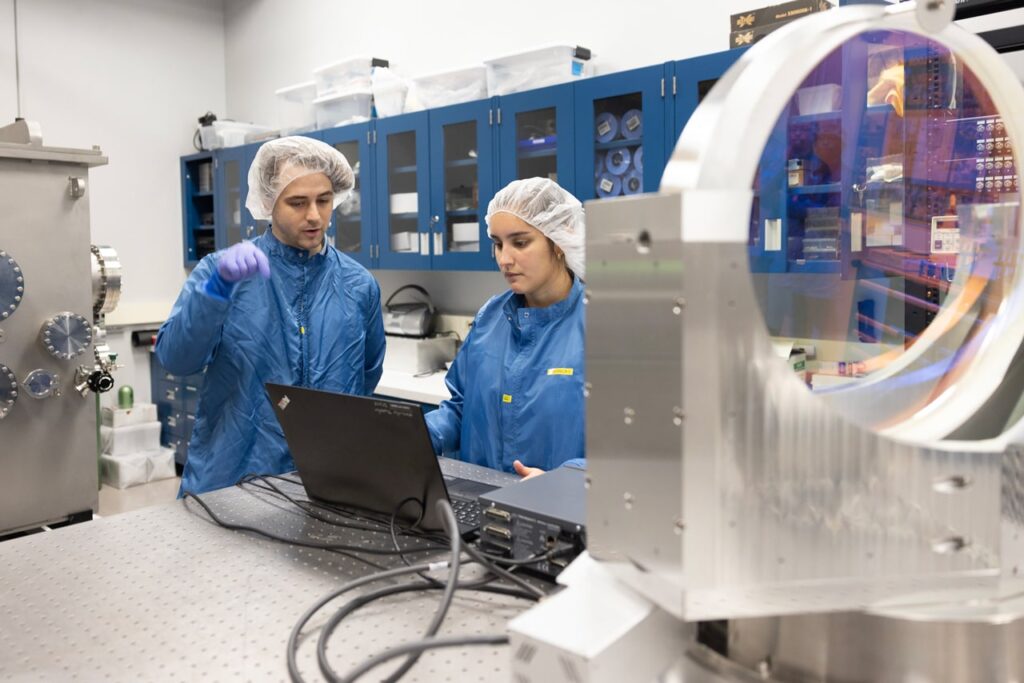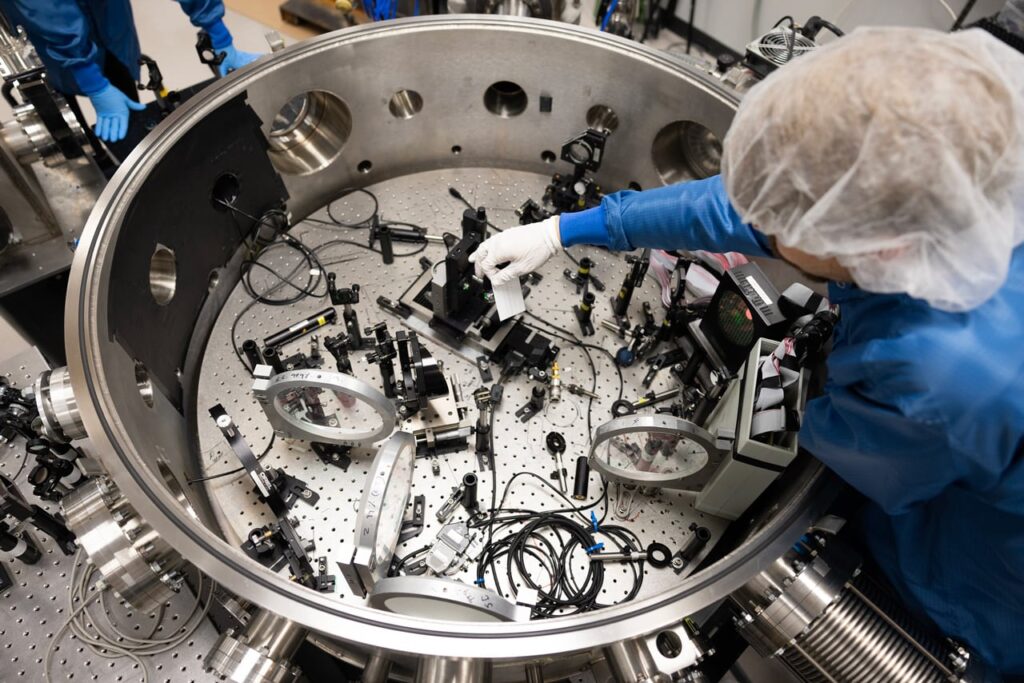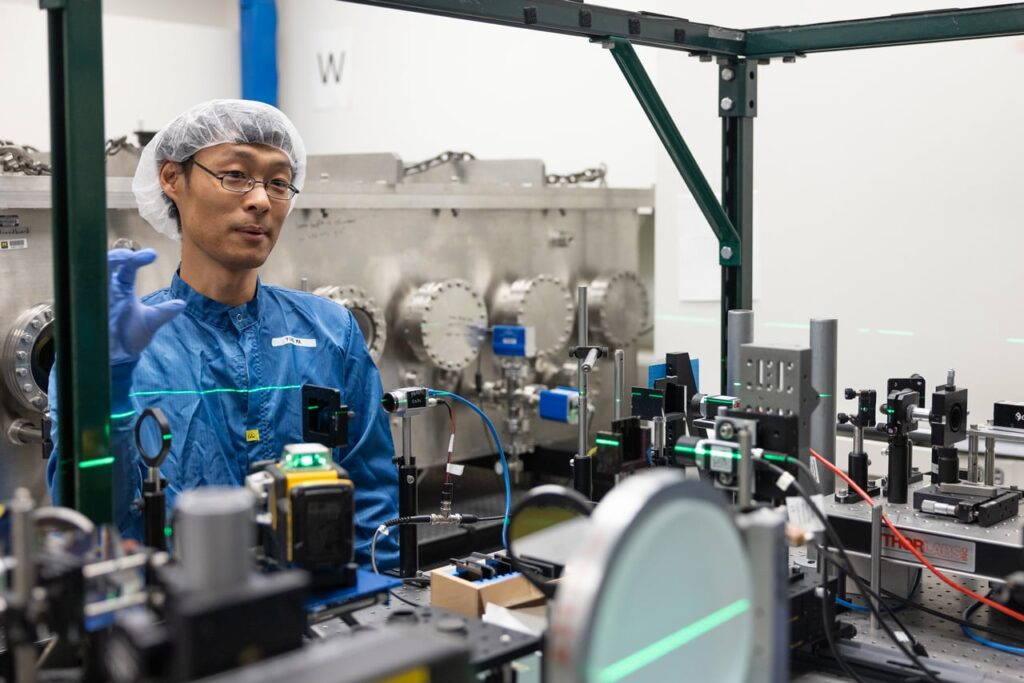Soon-to-be most powerful laser in the US is open for experiments

What will be the most powerful laser system in the US, built and run by the University of Michigan, is about to begin hosting research teams from around the world to probe the quantum laws underpinning reality and explore new ways to generate X-ray and particle beams. The findings could advance healthcare and microelectronics, provide insights into extreme astrophysics, and more.
After four years of construction, the team took a moment to celebrate the opening of the facility as they begin welcoming experimental teams as official users.
“At this milestone, we want to honor the people who designed and built the laser system, as well as those who made the lab space ready and built the systems that ensure that the laser is safe to operate. This celebration also expresses our gratitude for the support of the National Science Foundation (NSF), which funded the building and now the operation of the laser system,” said Louise Willingale, associate director of ZEUS and an associate professor of electrical and computer engineering.
Called ZEUS, the zettawatt-equivalent ultrashort pulse laser system is designed to lead the US with a peak power of three petawatts—about a thousand times the electricity consumption of the whole world, but for a few quintillionths of a second.
“A zettawatt is a 1 with 21 zeros behind it. We achieve a zettawatt equivalent with various tricks that enable strange, unusual and exciting physics. You’re focusing a laser into vacuum, and suddenly matter appears,” said Karl Krushelnick, director of the Gérard Mourou Center for Ultrafast Optical Science (CUOS), which houses ZEUS, and the Henry J. Gomberg Collegiate Professor of Engineering.

The grand opening ceremony included remarks from Nobel laureate Gérard Mourou. He developed the method for amplifying laser pulses employed by ZEUS and scaled it up at U-M, launching the university as a leader in the technique.
“It’s amazing,” said Mourou, who joined U-M in 1988 and founded CUOS in 1990.
He described the opening of the laser as an emotional moment for him. “We came with the idea to build high intensity lasers. And what we dreamed 35 years ago is what is existing now. This was a really incredible gift for me.”
Denise Caldwell, physics division director of the NSF, funded Mourou’s efforts to build CUOS and the HERCULES laser, which once held the world record for highest laser intensity. Many critical parts of HERCULES now power ZEUS.
“A new capability only takes hold in the community when it is translated from the developers to the broad spectrum of scientists to who can benefit, identifying new problems and scientific directions,” said Caldwell.
“Having a facility that is open to users from the full scientific community is going to enable new discoveries that even now we’re not aware of. Such a step into the future is what ZEUS is offering,” she said.
The first six external experiments have been selected by an independent panel of researchers in the field. They will begin to explore how well quantum electrodynamics, a reigning theory of the laws underpinning spacetime, holds up during the extreme interactions enabled by the powerful laser pulses.

Other experiments will investigate how to perform advanced imaging, produce radiation at the boundary between X-rays and UV light—and how to assess the performance of ZEUS and lasers like it.
“ZEUS is operated as an NSF-sponsored user facility, welcoming external researchers to conduct experiments through a competitive, peer-reviewed proposal system. This approach aims to advance the frontiers of science and foster discovery,” said Anatoly Maksimchuk, a research scientist in electrical and computer engineering, who leads the development of the experimental areas.
One of the capabilities that the team is most excited about is the ability to get very precise laser pulses through the use of deformable mirrors in the target areas. These can make up for imperfections in the myriad optical components in the greater-than-1,000-foot path that the laser pulses take.
“The university has been developing this technology for decades. With the new NSF facility, we are inviting people to U-M to do world-class experiments,” John Nees, a research scientist in electrical and computer engineering, who was among the team that Mourou brought from the University of Rochester when he came to Michigan. Nees leads the ZEUS laser construction.
When the laser fired its first shots in October last year, only the high-repetition target area was ready, designed to receive more frequent but lower power laser pulses. It will run at a maximum power of 0.5 petawatts, receiving up to five pulses per second—although in this first year, they’re planning on keeping it at a more stately one pulse per second.

This high rate is valuable for teams that are generating X-rays to do imaging experiments, such as using them to image soft tissues. Typical X-rays at the hospital or dentist reveal bone and other hard structures, running right through most tissues and organs. However, because these X-rays are in more organized pulses, it’s possible to identify different tissues by the way they bend the X-rays to different degrees.
In the coming year, experiments are also being scheduled in the solid target area most useful for reaching the highest intensities, and the target area for ZEUS’s signature experiment—where particles can experience a zettawatt-equivalent electric field.
“It’s really satisfying to have been here and watched the whole process over the last few years. From an empty building, to seeing the lab spaces filled in, and seeing the equipment moved in—and moving a lot of it myself. It’s exciting to see the final product and show it off,” said Paul Campbell, an assistant research scientist in electrical and computer engineering, who has been instrumental in preparing the solid target area.
At present, the laser system is running below power, awaiting parts such as the 6.7-inch titanium sapphire crystal needed to help amplify the beam to the full power. In addition, the system is still gradually ramping up, achieving 0.2 petawatts last year. By the end of this year, it should achieve 1 petawatt even without the larger crystal.
Then, starting in late 2024 or early 2025, the team hopes ZEUS will be ready to run the signature experiment. They will split the beam in two, use part of it to create a beam of electrons traveling at nearly the speed of light, and then run those electrons into the laser pulse. For the electrons, the laser pulse will seem a million times more powerful than three petawatts—enabling researchers to find out what zettawatt laser pulses could do.

“It’s really at the frontier,” said Yong Ma, an assistant research scientist in nuclear engineering and radiological sciences, who has done much of the preparation in the high repetition target area, as well as working together with Makismchuk and Campbell on the signature target area. “These quantum electrodynamics studies are not even in textbooks. This area is somewhere no one has investigated before.”
Roughly one hundred members of the U-M and ultrafast optical science community attended the ceremony and symposium.
“This exemplifies what we are all about at Michigan Engineering: Excellence in technology and engineering. Collaborative teamwork to meet our goals. And an inclusive and innovative community of service for the common good. Congratulations to the team,” said Steven Ceccio, the interim dean of engineering and the Vincent T. and Gloria M. Gorguze Professor of Engineering.